Ruoming Pang
Finding Fantastic Experts in MoEs: A Unified Study for Expert Dropping Strategies and Observations
Apr 10, 2025Abstract:Sparsely activated Mixture-of-Experts (SMoE) has shown promise in scaling up the learning capacity of neural networks. However, vanilla SMoEs have issues such as expert redundancy and heavy memory requirements, making them inefficient and non-scalable, especially for resource-constrained scenarios. Expert-level sparsification of SMoEs involves pruning the least important experts to address these limitations. In this work, we aim to address three questions: (1) What is the best recipe to identify the least knowledgeable subset of experts that can be dropped with minimal impact on performance? (2) How should we perform expert dropping (one-shot or iterative), and what correction measures can we undertake to minimize its drastic impact on SMoE subnetwork capabilities? (3) What capabilities of full-SMoEs are severely impacted by the removal of the least dominant experts, and how can we recover them? Firstly, we propose MoE Experts Compression Suite (MC-Suite), which is a collection of some previously explored and multiple novel recipes to provide a comprehensive benchmark for estimating expert importance from diverse perspectives, as well as unveil numerous valuable insights for SMoE experts. Secondly, unlike prior works with a one-shot expert pruning approach, we explore the benefits of iterative pruning with the re-estimation of the MC-Suite criterion. Moreover, we introduce the benefits of task-agnostic fine-tuning as a correction mechanism during iterative expert dropping, which we term MoE Lottery Subnetworks. Lastly, we present an experimentally validated conjecture that, during expert dropping, SMoEs' instruction-following capabilities are predominantly hurt, which can be restored to a robust level subject to external augmentation of instruction-following capabilities using k-shot examples and supervised fine-tuning.
Talking Turns: Benchmarking Audio Foundation Models on Turn-Taking Dynamics
Mar 03, 2025Abstract:The recent wave of audio foundation models (FMs) could provide new capabilities for conversational modeling. However, there have been limited efforts to evaluate these audio FMs comprehensively on their ability to have natural and interactive conversations. To engage in meaningful conversation with the end user, we would want the FMs to additionally perform a fluent succession of turns without too much overlapping speech or long stretches of silence. Inspired by this, we ask whether the recently proposed audio FMs can understand, predict, and perform turn-taking events? To answer this, we propose a novel evaluation protocol that can assess spoken dialog system's turn-taking capabilities using a supervised model as a judge that has been trained to predict turn-taking events in human-human conversations. Using this protocol, we present the first comprehensive user study that evaluates existing spoken dialogue systems on their ability to perform turn-taking events and reveal many interesting insights, such as they sometimes do not understand when to speak up, can interrupt too aggressively and rarely backchannel. We further evaluate multiple open-source and proprietary audio FMs accessible through APIs on carefully curated test benchmarks from Switchboard to measure their ability to understand and predict turn-taking events and identify significant room for improvement. We will open source our evaluation platform to promote the development of advanced conversational AI systems.
Instruction-Following Pruning for Large Language Models
Jan 07, 2025



Abstract:With the rapid scaling of large language models (LLMs), structured pruning has become a widely used technique to learn efficient, smaller models from larger ones, delivering superior performance compared to training similarly sized models from scratch. In this paper, we move beyond the traditional static pruning approach of determining a fixed pruning mask for a model, and propose a dynamic approach to structured pruning. In our method, the pruning mask is input-dependent and adapts dynamically based on the information described in a user instruction. Our approach, termed "instruction-following pruning", introduces a sparse mask predictor that takes the user instruction as input and dynamically selects the most relevant model parameters for the given task. To identify and activate effective parameters, we jointly optimize the sparse mask predictor and the LLM, leveraging both instruction-following data and the pre-training corpus. Experimental results demonstrate the effectiveness of our approach on a wide range of evaluation benchmarks. For example, our 3B activated model improves over the 3B dense model by 5-8 points of absolute margin on domains such as math and coding, and rivals the performance of a 9B model.
Improve Vision Language Model Chain-of-thought Reasoning
Oct 21, 2024



Abstract:Chain-of-thought (CoT) reasoning in vision language models (VLMs) is crucial for improving interpretability and trustworthiness. However, current training recipes lack robust CoT reasoning data, relying on datasets dominated by short annotations with minimal rationales. In this work, we show that training VLM on short answers does not generalize well to reasoning tasks that require more detailed responses. To address this, we propose a two-fold approach. First, we distill rationales from GPT-4o model to enrich the training data and fine-tune VLMs, boosting their CoT performance. Second, we apply reinforcement learning to further calibrate reasoning quality. Specifically, we construct positive (correct) and negative (incorrect) pairs of model-generated reasoning chains, by comparing their predictions with annotated short answers. Using this pairwise data, we apply the Direct Preference Optimization algorithm to refine the model's reasoning abilities. Our experiments demonstrate significant improvements in CoT reasoning on benchmark datasets and better generalization to direct answer prediction as well. This work emphasizes the importance of incorporating detailed rationales in training and leveraging reinforcement learning to strengthen the reasoning capabilities of VLMs.
Step-by-Step Reasoning for Math Problems via Twisted Sequential Monte Carlo
Oct 02, 2024



Abstract:Augmenting the multi-step reasoning abilities of Large Language Models (LLMs) has been a persistent challenge. Recently, verification has shown promise in improving solution consistency by evaluating generated outputs. However, current verification approaches suffer from sampling inefficiencies, requiring a large number of samples to achieve satisfactory performance. Additionally, training an effective verifier often depends on extensive process supervision, which is costly to acquire. In this paper, we address these limitations by introducing a novel verification method based on Twisted Sequential Monte Carlo (TSMC). TSMC sequentially refines its sampling effort to focus exploration on promising candidates, resulting in more efficient generation of high-quality solutions. We apply TSMC to LLMs by estimating the expected future rewards at partial solutions. This approach results in a more straightforward training target that eliminates the need for step-wise human annotations. We empirically demonstrate the advantages of our method across multiple math benchmarks, and also validate our theoretical analysis of both our approach and existing verification methods.
EC-DIT: Scaling Diffusion Transformers with Adaptive Expert-Choice Routing
Oct 02, 2024



Abstract:Diffusion transformers have been widely adopted for text-to-image synthesis. While scaling these models up to billions of parameters shows promise, the effectiveness of scaling beyond current sizes remains underexplored and challenging. By explicitly exploiting the computational heterogeneity of image generations, we develop a new family of Mixture-of-Experts (MoE) models (EC-DIT) for diffusion transformers with expert-choice routing. EC-DIT learns to adaptively optimize the compute allocated to understand the input texts and generate the respective image patches, enabling heterogeneous computation aligned with varying text-image complexities. This heterogeneity provides an efficient way of scaling EC-DIT up to 97 billion parameters and achieving significant improvements in training convergence, text-to-image alignment, and overall generation quality over dense models and conventional MoE models. Through extensive ablations, we show that EC-DIT demonstrates superior scalability and adaptive compute allocation by recognizing varying textual importance through end-to-end training. Notably, in text-to-image alignment evaluation, our largest models achieve a state-of-the-art GenEval score of 71.68% and still maintain competitive inference speed with intuitive interpretability.
ToolSandbox: A Stateful, Conversational, Interactive Evaluation Benchmark for LLM Tool Use Capabilities
Aug 08, 2024
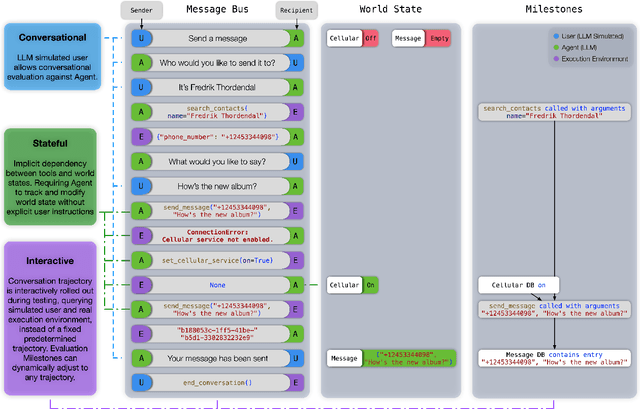
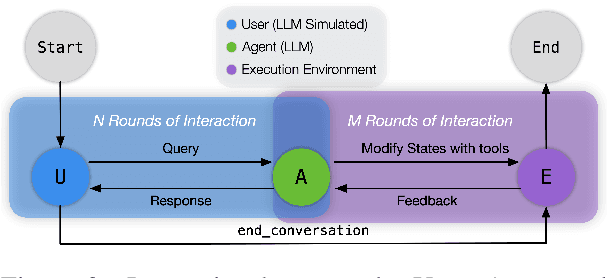
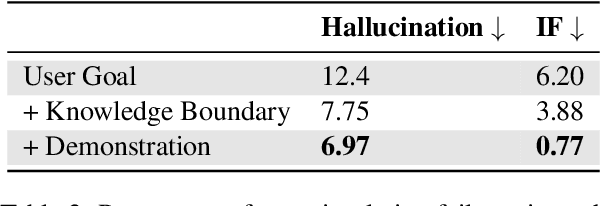
Abstract:Recent large language models (LLMs) advancements sparked a growing research interest in tool assisted LLMs solving real-world challenges, which calls for comprehensive evaluation of tool-use capabilities. While previous works focused on either evaluating over stateless web services (RESTful API), based on a single turn user prompt, or an off-policy dialog trajectory, ToolSandbox includes stateful tool execution, implicit state dependencies between tools, a built-in user simulator supporting on-policy conversational evaluation and a dynamic evaluation strategy for intermediate and final milestones over an arbitrary trajectory. We show that open source and proprietary models have a significant performance gap, and complex tasks like State Dependency, Canonicalization and Insufficient Information defined in ToolSandbox are challenging even the most capable SOTA LLMs, providing brand-new insights into tool-use LLM capabilities. ToolSandbox evaluation framework is released at https://github.com/apple/ToolSandbox
Apple Intelligence Foundation Language Models
Jul 29, 2024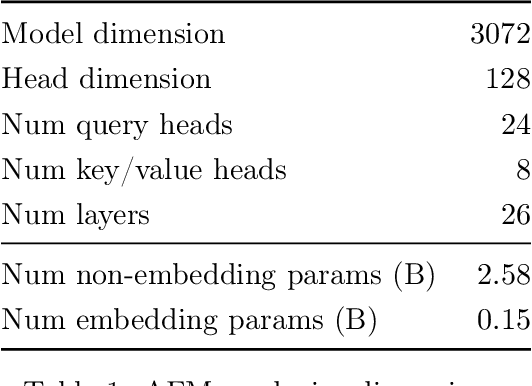
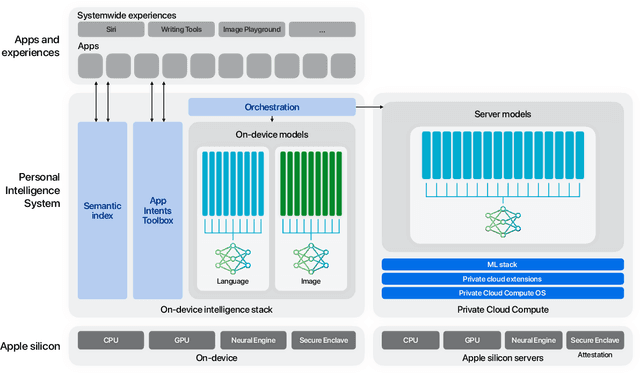

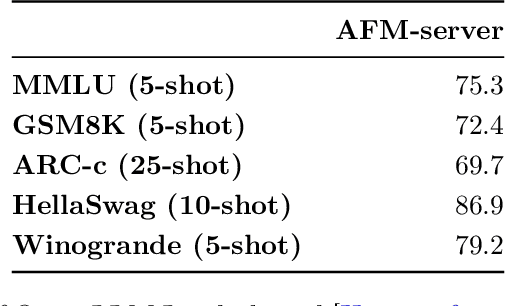
Abstract:We present foundation language models developed to power Apple Intelligence features, including a ~3 billion parameter model designed to run efficiently on devices and a large server-based language model designed for Private Cloud Compute. These models are designed to perform a wide range of tasks efficiently, accurately, and responsibly. This report describes the model architecture, the data used to train the model, the training process, how the models are optimized for inference, and the evaluation results. We highlight our focus on Responsible AI and how the principles are applied throughout the model development.
Large Language Model-guided Document Selection
Jun 07, 2024



Abstract:Large Language Model (LLM) pre-training exhausts an ever growing compute budget, yet recent research has demonstrated that careful document selection enables comparable model quality with only a fraction of the FLOPs. Inspired by efforts suggesting that domain-specific training document selection is in fact an interpretable process [Gunasekar et al., 2023], as well as research showing that instruction-finetuned LLMs are adept zero-shot data labelers [Gilardi et al.,2023], we explore a promising direction for scalable general-domain document selection; employing a prompted LLM as a document grader, we distill quality labels into a classifier model, which is applied at scale to a large, and already heavily-filtered, web-crawl-derived corpus autonomously. Following the guidance of this classifier, we drop 75% of the corpus and train LLMs on the remaining data. Results across multiple benchmarks show that: 1. Filtering allows us to quality-match a model trained on the full corpus across diverse benchmarks with at most 70% of the FLOPs, 2. More capable LLM labelers and classifier models lead to better results that are less sensitive to the labeler's prompt, 3. In-context learning helps to boost the performance of less-capable labeling models. In all cases we use open-source datasets, models, recipes, and evaluation frameworks, so that results can be reproduced by the community.
Revisiting MoE and Dense Speed-Accuracy Comparisons for LLM Training
May 23, 2024



Abstract:Mixture-of-Experts (MoE) enjoys performance gain by increasing model capacity while keeping computation cost constant. When comparing MoE to dense models, prior work typically adopt the following setting: 1) use FLOPs or activated parameters as a measure of model complexity; 2) train all models to the same number of tokens. We argue that this setting favors MoE as FLOPs and activated parameters do not accurately measure the communication overhead in sparse layers, leading to a larger actual training budget for MoE. In this work, we revisit the settings by adopting step time as a more accurate measure of model complexity, and by determining the total compute budget under the Chinchilla compute-optimal settings. To efficiently run MoE on modern accelerators, we adopt a 3D sharding method that keeps the dense-to-MoE step time increase within a healthy range. We evaluate MoE and dense LLMs on a set of nine 0-shot and two 1-shot English tasks, as well as MMLU 5-shot and GSM8K 8-shot across three model scales at 6.4B, 12.6B, and 29.6B. Experimental results show that even under these settings, MoE consistently outperform dense LLMs on the speed-accuracy trade-off curve with meaningful gaps. Our full model implementation and sharding strategy will be released at~\url{https://github.com/apple/axlearn}
 Add to Chrome
Add to Chrome Add to Firefox
Add to Firefox Add to Edge
Add to Edge